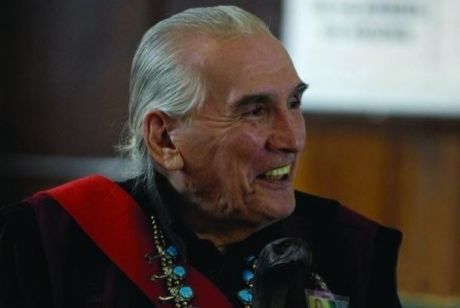Obituaries
You are here
Asini Vern Harper: Red Power leader

May 20, 2018
One of the high points of the Red Power movement was the Native People’s Caravan of 1974. Several hundred Indigenous activists travelled across Turtle Island, from Vancouver to Ottawa, to assert their inherent rights and to protest the federal government’s ongoing betrayal of historic treaties.
One of the Caravan’s leaders was Vern Harper, a Cree activist who resided in Tkaranto and died this May at the age of 85 after a life full of commitment to Indigenous peoples. Harper would later recount the protest in his book The Red Road: The Native People’s Caravan, 1974.
Political development
Harper came from a long line of fighters as a sixth generation grandson of Big Bear, who fought the last battle between the Cree and the Canadian government in 1885. To escape a traumatic upbringing Harper joined the American military and at the age of 17 served in the 82nd Airborne Division in the Korean War. But within 10 years his overt political development had begun, influenced by the rise of the Red Power movement of the 1960s. He became a leader of the American Indian Movement after returning to his birthplace in Tkaranto.
By 1972 Harper was vice-president of the Ontario Metis and Non-Status Indian Association and along with the Ojibway Warrior Society of Kenora and the Regina Warrior Society, he helped create the Native People’s Caravan. On Parliament Hill, there were three lines of police. Indigenous people were unarmed, but police had bayonets and tear gas. As co-organizer Louis Cameron observed, “I think that the event of the riot police attacking the people of the demonstration was a retaliation of the federal justice department of Canada and also particularly the Province of Ontario to retaliate on the native people for their armed insurrection at Anicinabe Park (Kenora)…We took up guns and freed ourselves from that (government dictatorship) but in return, the police and the government came running down with guns and clubs.”
National liberation and class unity
Some Red Power activists, including Harper and Metis Marxist Howard Adams, were heavily influenced by nationalist struggles for self-determination happening in Africa and Vietnam, and in their ideological explorations found that Marxist explanations of the causes of oppression and imperialism made the most sense.
Harper offered the following analysis of events in 1974: “One of the key factors that made ’74 a turning point was that native activists, for the first time in their generation, realized that there was non-native support for their cause. The isolation of the natives, used by the state, is no longer effective…We see trade unions, progressive left groups, church groups such as the Quakers, even liberal elements give support, such as funds, telegrams, participating in demonstrations, letters to Members of Parliament denouncing the tactics of the state, to help us. There’s a more militant and revolutionary theme emerging, which is beginning to get support from all elements of the native movement…Native and non-native people are seeing that capitalism doesn’t serve the masses. It only protects the capitalists’ interests.”
In 1976 Harper co-founded the First Nations School of Toronto to instil Indigenous students with a strong sense of pride and cultural strength. As a respected “urban” Elder, he went on to become a spiritual leader in prisons, leading traditional ceremonies and providing traditional counselling. Activists in Idle No More and Indigenous (and non-Indigenous) defenders of the land and water stand on the shoulders of leaders like Asini (Cree word for “stone”) Vern Harper.
Section:










